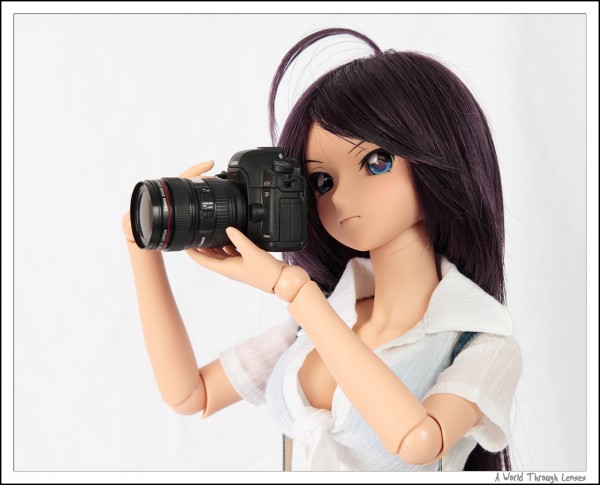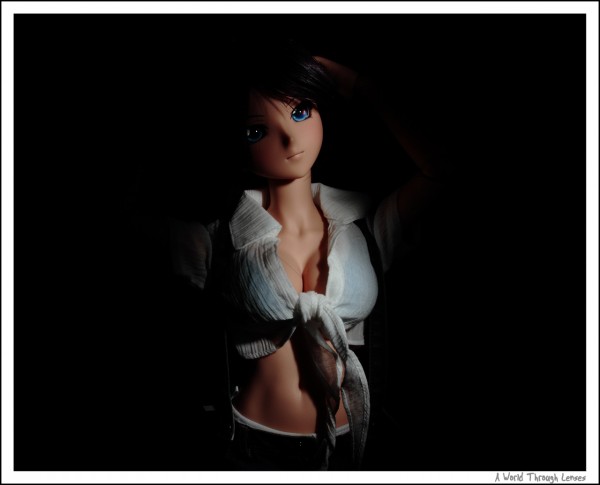 phoenix |  September 6th, 2010 This is another one of my figure/doll photography 121 post. A few months ago, I’ve posted an article on how to produce a true black background without the use of any black background material and/or image editing software. I wrote about the black background because I find most people does not know how light works its magic in a photography sense. The people I talk to tends to instinctively come to the conclusion that if a photo’s background is black, then there must be something black behind it. If you have read my article, then you would see that a true black background actually resulted from a lack of light coming towards to your camera. Today I want to look at the opposite side of the gray scale — how to produce a white background?
Well again a lot of people instinctively think that a white background is the result of placing some kind of white material behind the subject. Below is a photo that I took in front of a white fabric backdrop. However, when compared to the white frame that borders the picture, you can clearly see that the actual background is not 100% white. In fact if you load it into an image editing software, you will see that the background is somewhere between 96% – 92% on the gray scale. On the gray scale there’s only one white point which is at the very end of the gray scale. Anything that’s not 100% on the gray scale, or 255, 255, 255 in RGB value is not pure white. And 255, 255, 255 RGB value is what the background must be if we were to call it a true white background. Anything less is just a different shades of gray.

Continue reading ‘Figure/doll photography 121 – How to produce white background’ »
 phoenix |  February 27th, 2010 This is another figure/doll photography 121 post. I’ve heard from many people as well as seen from many forum posters that they can’t seem to get sharp images for their figure/doll. Some of these people simply didn’t know to use the macro focus mode on their point and shoot camera. However, a lot of them are new users of D-SLRs or have switched from point and shoot digital camera to D-SLRs. In this post, I’d like to explore some of the difference between a point and shoot digital camera and a D-SLR that may cause new and unfamiliar user to get blurry photos. I will also explore a few things on the D-SLR and are specific to D-SLR that may cause blurry photos. I will be using nendoroid, standard PVC figure, as well as doll as my subject. As usual all photos in the post have higher resolution images linked so click on the thumbnail to see better details.

Be aware, this post is image heavy and may take a bit longer to load.
Continue reading ‘Figure/doll photography 121 – Blurry photos – How to tame the focus’ »
 phoenix |  February 25th, 2010 I’m going to call this a figure/doll photography 121. It’s not a 101 because even though what’s presented here is what I know of, it may or may not be correct. It’s not a 123 since I’m not really providing a step by step instruction. So some where between 101 and 123, I hope this becomes helpful to someone. And through that, the knowledge is transferred from one to another, and hence the name 121.
Black background, there are a lot of myths about it. There are talks about how to use black seamless paper, black cloth, or even black velvet behind the subject to create it. Then there are talks about using post production editing tools such as Photoshop to achieve it. However, neither of these approaches produces what I would call a true black background. Black background material is always visible due to light reflection, even black velvet shows up under some lighting conditions. And then there are many cases where the use of background material is just not practical or not possible. Photoshop on the other hand, will product a true black background, but typical masking technique to mask out your suject will produce an unnatural edge around it, this is on top of the amount of work needed to mask the fine details. In this post, I will try to walk through my technique in creating what I would call a true black background, just like what I have done below for Dollfie Dream Kanu Unchou. I’ve used this technique for many years now, mostly for floral photography but used sparsely for figure photography as well. however it can easily be applied to much bigger subjects such as dolls, real people and even other bigger subjects that you might want to photograph. And it’s all done straight out of camera with no background material and no Photoshop work.

Continue reading ‘Figure/doll photography 121 – How to produce black background’ »
|
|


